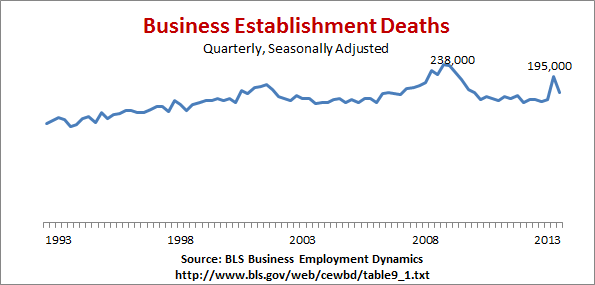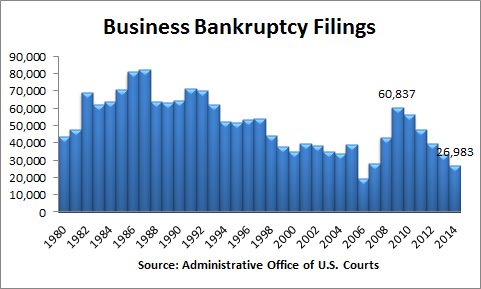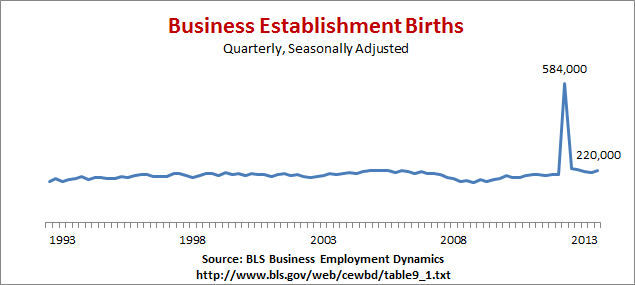In announcing his presidential candidacy, Sen. Ted Cruz painted a bleak picture of “economic stagnation” and “record numbers” of small-business failures. He’s off base on both counts.
- Far from being stagnant, the U.S. economy has chalked up five straight years of growth, gaining nearly 11.5 million jobs since early 2010.
- It is actually new business establishment openings that have recently posted the biggest gains on record. The number of business establishment deaths is currently well below the record — which was set in late 2008 .
When Cruz announced his run for the Republican nomination March 23, we quickly noted a number of the Texas senator’s dubious claims in an item we called “FactChecking Cruz.” But wait, there’s more.
‘Economic Stagnation’
In his address at Liberty University, Cruz repeatedly asked his audience to “imagine” a better economic future. Better than what? Cruz used the classic “straw man” deception, pitting his own bright vision of the future against a sham version of the present.
Cruz said millions of young people are “scared” and “worried about the future.” Perhaps so. But then he said:
Cruz, March 23: Think just how different the world would be. Imagine instead of economic stagnation, booming economic growth.
“Economic stagnation” is commonly defined to mean a prolonged period of little or no growth, and the fact is that real (inflation-adjusted) U.S. gross domestic product grew 2.4 percent last year, which was also the best year for job growth in 15 years.
It was the fifth straight year of annual increases in GDP. Since job losses from the Great Recession of 2007-2009 finally turned around in February 2010, the U.S. has gained nearly 11.5 million jobs. Corporate profits have soared to new records, as have stock prices.
All that may or may not quite qualify as “booming” economic growth, but it’s incorrect to call it “stagnation.” The worst that Cruz could accurately say about recent economic growth is that it is somewhat below the historical average.
The average annual change in U.S. real GDP since World War II has been just under 3 percent, while the U.S. economy gained 2.2 percent in 2013, 2.3 percent in 2012, 1.6 percent in 2011 and 2.5 percent in 2010.
‘Record’ Small-Business Deaths
Cruz also got it wrong when he spoke of small businesses closing their doors in “record” numbers:
Cruz, March 23: Instead of small businesses going out of business in record numbers, imagine small businesses growing and prospering.
Actually, the number of business establishment deaths is down by 18 percent from the record of 238,000 — a peak that occurred in the last three months of 2008.
The number of establishments that had closed their doors for at least a full year was 195,000 in the three months ending in September 2013, according to the most recent quarterly figures on business births and deaths from the Bureau of Labor Statistics Business Employment Dynamics report.
As a check on the BLS numbers, we also looked at business bankruptcies, and they are nowhere near “record” levels.
Since the Bankruptcy Abuse Prevention and Consumer Protection Act of 2005 was signed into law — making it more difficult to file for bankruptcy — the highest annual number of business filings for bankruptcy was just under 61,000 in the recession-plagued year of 2009, according to figures from the Administrative Office of U.S. Courts, as compiled by the American Bankruptcy Institute.
Last year the number of business bankruptcies was down by more than half — to 26,983.
These bankruptcy figures count filings by businesses of all sizes, but practically all of them are small. Less than one-third of 1 percent of all business firms have more than 500 employees, according to Census figures.
Bankruptcy isn’t the only reason a firm goes out of business, of course. Profitable firms can be sold, merged or just abandoned when aging owners decide its time to retire. But if closings were going up, we would expect bankruptcies to be going up also.
And while both business deaths and business bankruptcies are declining, births of new business establishments have recently hit new records.
What is the record for business births? We’ll disregard the huge spike of 584,000 new establishments, which appeared in the first three months of 2013. That’s a statistical fluke that came about when BLS began counting health care workers who serve seniors in their homes as employees of an “establishment” rather than as household workers, resulting in a surge of previously uncounted “establishments.”
Ignoring that — the record is 229,000 establishment births, posted in the second quarter of 2013, and the next highest total was 224,000 establishment births during the third quarter of that year. In the most recent quarter on record — ending in June of last year — there were 220,000 establishment births, still one of the highest on record. BLS started this statistical series in 1992.
A technical note: All these figures exclude the self-employed. An establishment is counted as “born” when its first employee shows up as being covered by unemployment insurance.
Suffice to say, Cruz just got it wrong when he spoke of “small businesses going out of business in record numbers.” And we weren’t the only ones to notice. Our friends at Politifact.com rated that statement as “false” on the website’s truth-o-meter, relying on a different set of figures — from the Census Bureau.
The Cruz campaign has yet to respond to our repeated requests for some evidence supporting his claim. Politifact said it didn’t get a response from the campaign, either.
— Brooks Jackson


